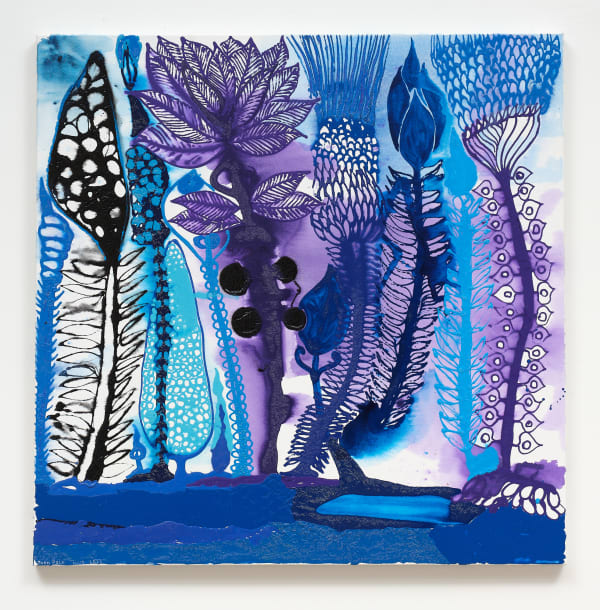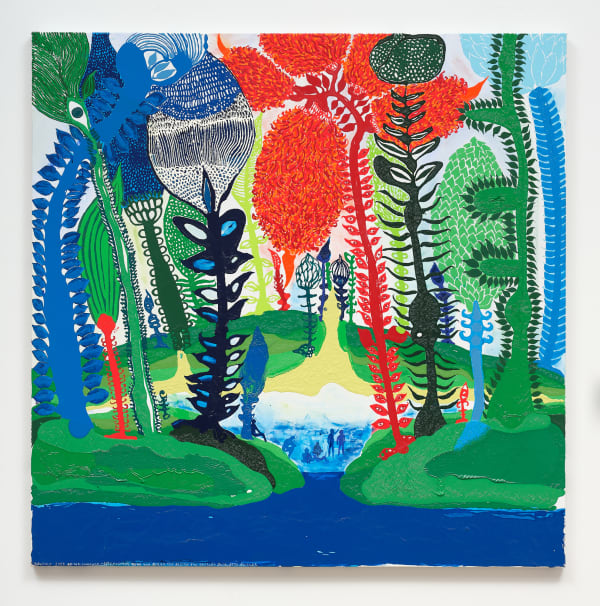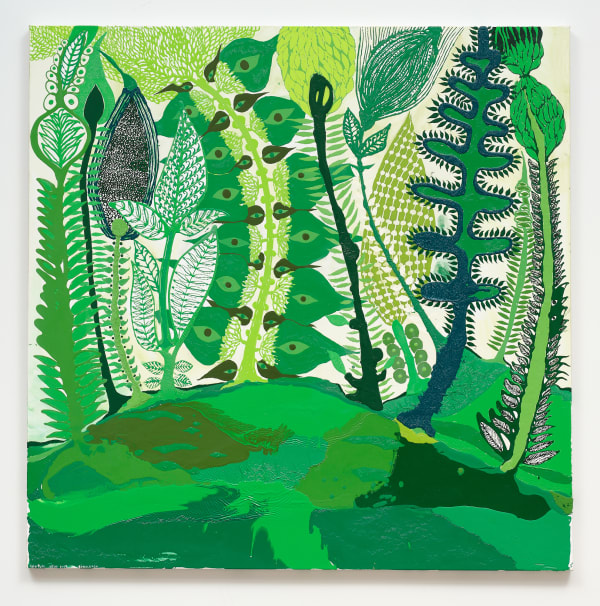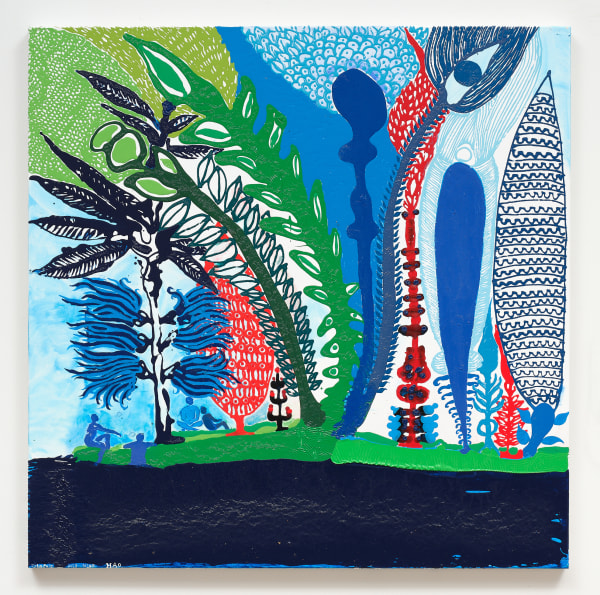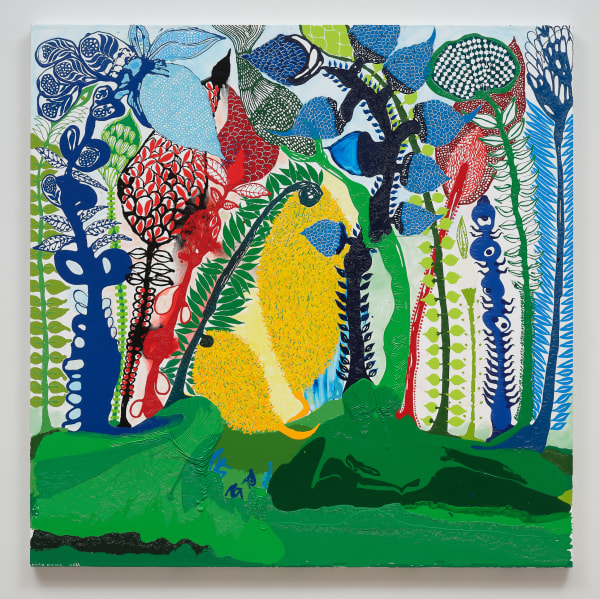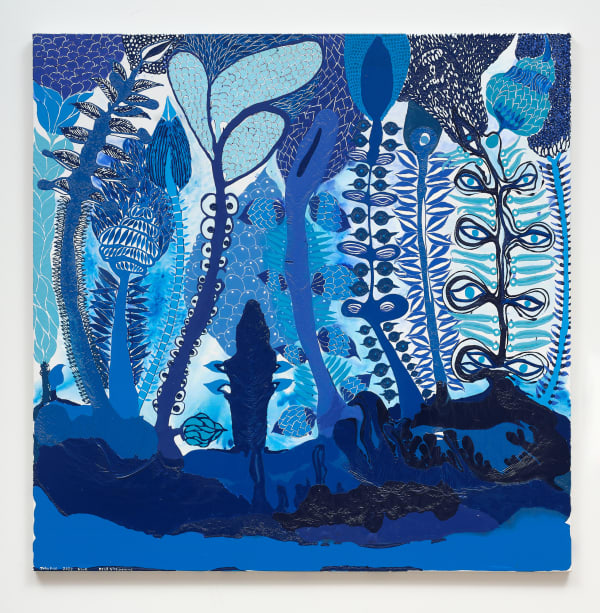Haia: John Pule
For nine months I rode my bike each day through the canopy forest from Liku to Alofi [around 15 kilometres]. Through rain or shine, winds, storm, or calm. The road is bordered with plantations, forests, tracks into the interior. Big blue skies and clouds, shadows of trees stretch across the makatea (limestone) road. Returning to Liku every evening, the sun is warm on my back. These paintings and drawings are about that particular time.
Haia brings together a body of recent paintings and drawings by John Pule. With bursts of bright colour, painterly suggestions of water, vast tropical vegetation and silhouetted human figures, the works presented in Haia further the rich artistic vision that has made Pule a widely celebrated artist in Aotearoa and beyond.
This body of work was created by Pule over a nine-month period in Niue. In January 2023, he was offered a studio by the Niue Government in a space located in the historical Fale Fono parliament building in Sialekula, Alofi. Pule states, “The studio faces the ocean on the west side of the capital, Alofi. When I paint, I hear only the ocean. Sialekula, the name of the land the Fale fono is built on, means ‘red gardenia’.
-
 John Pule, Niue, 2023
John Pule, Niue, 2023 -
 John Pule, As we stood one misty morning near the ocean the desire the solitude gone. gone forever, 2023
John Pule, As we stood one misty morning near the ocean the desire the solitude gone. gone forever, 2023 -
 John Pule, Takeleaga, 2023
John Pule, Takeleaga, 2023 -
 John Pule, Hina, 2023
John Pule, Hina, 2023 -
 John Pule, Hao, 2023
John Pule, Hao, 2023 -
 John Pule, Haia, 2023
John Pule, Haia, 2023 -
 John Pule, Tukumuitea/Forever and Ever, 2023
John Pule, Tukumuitea/Forever and Ever, 2023 -
 John Pule, Deep Niue Evening, 2023
John Pule, Deep Niue Evening, 2023 -
 John Pule, Kua Kelokelo e Lāa Ke Tō / Ukutoka, 2023
John Pule, Kua Kelokelo e Lāa Ke Tō / Ukutoka, 2023 -
 John Pule, Many times at night I sit up and watch you sleep, 2023
John Pule, Many times at night I sit up and watch you sleep, 2023 -
 John Pule, Mioimioi, 2023
John Pule, Mioimioi, 2023 -
 John Pule, These hot evenings make dreaming difficult, 2023
John Pule, These hot evenings make dreaming difficult, 2023 -
 John Pule, Foulua Pukenamo Tau Misi, 2022
John Pule, Foulua Pukenamo Tau Misi, 2022 -
 John Pule, Nakai Fai Mena Ke Lekua A Koe / Tukulagi / Tukumuitea / Maveheaga, 2023
John Pule, Nakai Fai Mena Ke Lekua A Koe / Tukulagi / Tukumuitea / Maveheaga, 2023
Haia brings together a body of recent paintings and drawings by John Pule. With bursts of bright colour, painterly suggestions of water, vast tropical vegetation and silhouetted human figures, the works presented in Haia further the rich artistic vision that has made Pule a widely celebrated artist in Aotearoa and beyond.
This body of work was created by Pule over a nine-month period in Niue. In January 2023, he was offered a studio by the Niue Government in a space located in the historical Fale Fono parliament building in Sialekula, Alofi. Pule states, “The studio faces the ocean on the west side of the capital, Alofi. When I paint, I hear only the ocean. Sialekula, the name of the land the Fale fono is built on, means ‘red gardenia’.
This environment has influenced Pule’s artistic output in these works. He states, “For nine months I rode my bike each day through the canopy forest from Liku to Alofi [around 15 kilometres]. Through rain or shine, winds, storm, or calm. The road is bordered with plantations, forests, tracks into the interior. Big blue skies and clouds, shadows of trees stretch across the makatea (limestone) road. Returning to Liku every evening, the sun is warm on my back. These paintings and drawings are about that particular time.” A sense of this environment, and the artist’s daily journeys through it, is palpable in the paintings.
Writer Gregory O’Brien once stated, “John Pule’s paintings are images of a self in a perpetual state of construction - of Jungian ‘individuation’.[1] This rings true in the works presented in Haia. Yet, on another level, they could be read as vibrant painterly responses to a particular setting – less about the artist as an individual, more about the artist as a conduit for environment and culture.
Haia includes eight brightly colourful canvasses and a similar number of largely monochromatic works on paper. The essential themes are the same, presenting Pule’s artistic responses to a period of time in Niue, though the canvas works are more painterly, the works on paper more graphic. “The ink drawings were drawn in my hut in Liku,” Pule says. “In these drawings, there are references to the empty hurricane houses built in the 1960s, and references to the church in Liku. The texts and many of the images are sourced from my journals, which I constantly draw and write in.”
There are numerous expressions and phrases in Niuean incorporated into the works, referring to sunsets, sunrises, dreams, ships, diving, and the sea. “The title ‘kua kelokelo a la’ translates as ‘the sun is about to set’. ‘Ukutoka’, translates as ‘dive deep’ or to dive for as long as possible. Another word ‘Miomio’ means something that can’t keep still. Often, I write ‘Kavaka’ on the drawings. This is the name of the land I live on in Liku. ‘Mena koa’ means extraordinary things. ‘Foulua pukenamo tau misi’ means ship full of dreams.” These translations offer yet more insight into the meaning of the works, relating to the rhythms of life in Niue, the land and environment, and the ever-present sea.
Pule states that the title, Haia, is a word commonly used in Niuean conversation. “It means: whether you like it or not, it’s the best I can do. Take it or leave it,” he says. As he has demonstrated again and again over the course of decades, the best he can do is simply stunning, richly detailed and nuanced, and among the finest contemporary art ever to come out of Oceania.
[1] Gregory O’Brien, “A Portrait of the Artist as Many People”. In Huaga: The Art of John Pule, edited by Nicholas Thomas (Dunedin: Otago University Press), 2010. Pp 11-21. Page 20.

